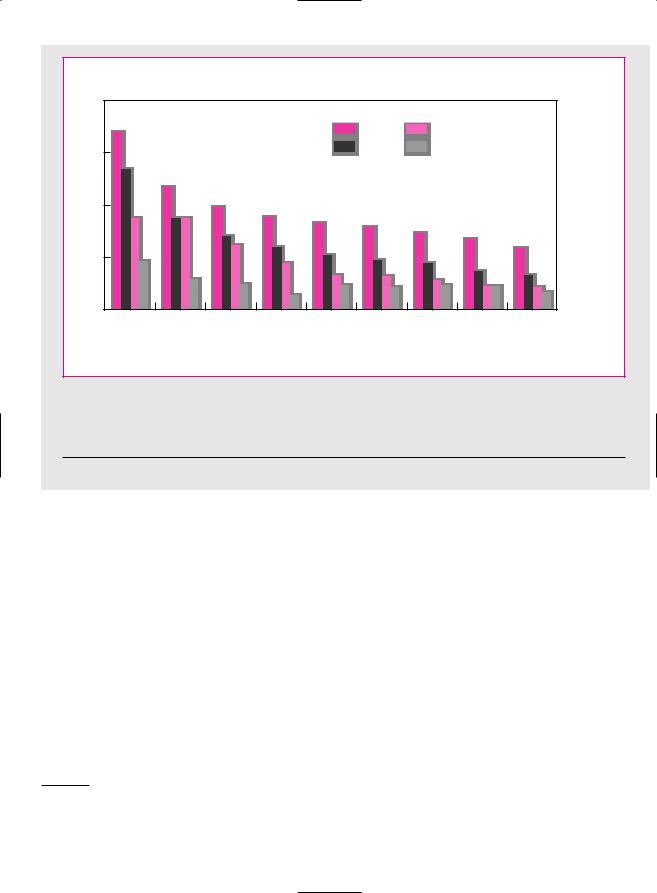

CHAPTER 15 How Corporations Issue Securities |
411 |
Canada
France
Netherlands
Australia
Hong Kong
UK
USA
Italy
Japan
Germany
Taiwan
Singapore
Mexico
India
Switzerland
Greece
Korea
Brazil
0 |
10 |
20 |
30 |
40 |
50 |
60 |
70 |
80 |
Return, percent
F I G U R E 1 5 . 2
Average initial returns from investing in IPOs in different countries.
Source: T. Loughran, J. R. Ritter, and K. Rydqvist, “Initial Public Offerings: International Insights,” Pacific-Basin Finance Journal 2 (1994), pp. 165–199, updated on www.bear.cba.ufl.edu/ritter.
We admit that the Netscape issue was unusual25 but researchers have found that investors who buy at the issue price on average commonly realize very high returns over the following weeks. For example, a study by Ibbotson, Sindelar, and Ritter of nearly 15,000 U.S. new issues from 1960 to 2000 found average underpricing of 18.4 percent.26 Figure 15.2 shows that the United States is not the only country in which IPOs are underpriced. In Brazil the gains from buying IPOs have averaged nearly 80 percent.27
You might think that shareholders would prefer not to sell their stock for less than its market price, but many investment bankers and institutional investors argue that underpricing is in the interests of the issuing firm. They say that a low offering price on the initial offer raises the price of the stock when it is subsequently traded in the market and enhances the firm’s ability to raise further capital.28 Skeptics respond that investment bankers push for a low offering price because it
25It does not, however, hold the record. That honor goes to Va Linux.
26R. G. Ibbotson, J. L. Sindelar, and J. R. Ritter, “The Market’s Problems with the Pricing of Initial Public Offerings,” Journal of Applied Corporate Finance 7 (Spring 1994), pp. 66–74, updated on http://bear.cba.ufl.edu/ritter. As we saw in Chapter 13, there is some evidence that these early gains are not maintained and in the five years following an IPO the shares underperform the market.
27There wasn’t room on the chart to plot Chinese IPOs; their initial returns have averaged 257 percent.
28For an analysis of how a firm could rationally underprice to facilitate subsequent stock issues, see I. Welch, “Seasoned Offerings, Imitation Costs and the Underpricing of Initial Public Offerings,” Journal of Finance 44 (June 1989), pp. 421–449.

412 |
PART IV Financing Decisions and Market Efficiency |
reduces the risk that they will be left with unwanted stock and makes them popular with their clients who are allotted stock.
Winner’s Curse
Here is another reason that new issues may be underpriced. Suppose that you bid successfully for a painting at an art auction. Should you be pleased? It is true that you now own the painting, which was presumably what you wanted, but everybody else at the auction apparently thought that the picture was worth less than you did. In other words, your success suggests that you may have overpaid.
This problem is known as the winner’s curse. The highest bidder in an auction is most likely to have overestimated the object’s value and, unless bidders recognize this in their bids, the buyer will on average overpay. If bidders are aware of the danger, they are likely to adjust their bids down correspondingly.
The same problem arises when you apply for a new issue of securities. For example, suppose that you decide to apply for every new issue of common stock. You will find that you have no difficulty in getting stock in the issues that no one else wants. But, when the issue is attractive, the underwriters will not have enough stock to go around, and you will receive less stock than you wanted. The result is that your money-making strategy may turn out to be a loser. If you are smart, you will play the game only if there is substantial underpricing on average.
Here then we have a possible rationale for the underpricing of new issues. Uninformed investors who cannot distinguish which issues are attractive are exposed to the winner’s curse. Companies and their underwriters are aware of this and need to underprice on average to attract the uninformed investors.29
15.3 OTHER NEW-ISSUE PROCEDURES
Table 15.2 summarizes the main steps involved in making an initial public offering of stock in the United States. You can see that Marvin’s new issue was a typical IPO in almost every respect. In particular most IPOs in the United States use the bookbuilding method in which the underwriter builds a book of likely orders and uses this information to set the issue price.
Although bookbuilding is rapidly gaining in popularity throughout the world,30 firms and governments in different countries employ a variety of techniques for selling their securities. The main alternatives to bookbuilding are a fixed price offer or an auction. The fixed price offer is often used for IPOs in the UK. In this case the firm fixes the selling price and then advertises the number of shares on offer. If the price is set too high, investors will not apply for all the shares on offer and the underwriters will be obliged to buy the unsold shares. If the price is set too low, the applications will exceed the number of shares on offer and investors
29Notice that the winner’s curse would disappear if only investors knew what the market price was going to be. One response is to allow trading in a security before it has been issued. This is known as a gray market and is most common for debt issues. Investors can observe the price in the gray market and can be more confident that they are not overbidding when the actual issue takes place.
30The growth in bookbuilding is discussed in A. E. Sherman, “Global Trends in IPO Methods: Book Building vs. Auctions,” working paper, Department of Finance and Business Economics, University of Notre Dame, March 2001.


414 |
PART IV Financing Decisions and Market Efficiency |
It might seem from our example that the proceeds from a uniform-price auction would be lower than from a discriminatory auction. But this ignores the fact that the uniform-price auction provides better protection against the winner’s curse. Wise bidders know that there is little cost to overbidding in a uniform-price auction, but there is potentially a very high cost to doing so in a discriminatory auction.33 Economists therefore often argue that the uniform-price auction should result in higher proceeds.34
Sales of bonds by the U.S. Treasury used to take the form of discriminatory auctions so that successful buyers paid their bid. However, governments do occasionally listen to economists, and the Treasury has now switched to a uniform-price auction. The Mexican government has also been sufficiently convinced to change from a discriminatory auction to a uniform-price auction.35
15.4 SECURITY SALES BY PUBLIC COMPANIES
For most companies their first public issue of stock is seldom their last. As they grow, they are likely to make further issues of debt and equity. Public companies can issue securities either by offering them to investors at large or by making a rights issue that is limited to existing stockholders. General cash offers are now used for virtually all debt and equity issues in the United States, but rights issues are widespread in other countries and you should understand how they work. Therefore in Appendix A to this chapter we describe rights issues.
General Cash Offers
When a corporation makes a general cash offer of debt or equity in the United States, it goes through much the same procedure as when it first went public. In other words, it registers the issue with the SEC and then sells the securities to an underwriter (or a syndicate of underwriters), who in turn offers the securities to the public. Before the price of the issue is fixed the underwriter will build up a book of likely demand for the securities just as in the case of Marvin’s IPO.
The SEC allows large companies to file a single registration statement covering financing plans for up to two years into the future. The actual issues can then be done with scant additional paperwork, whenever the firm needs the cash or thinks it can issue securities at an attractive price. This is called shelf registra-
33In addition, the price in the uniform-price auction depends not only on the views of B but also on those of A (for example, if A had bid $990 rather than $1,020, then both A and B would have paid $990 for each bond). Since the uniform-price auction takes advantage of the views of both A and B, it reduces the winner’s curse.
34Sometimes auctions reduce the winner’s curse by allowing uninformed bidders to enter noncompetitive bids, whereby they submit a quantity but not a price. For example, in U.S. Treasury auctions investors may submit noncompetitive bids and receive their full allocation at the average price paid by competitive bidders.
35Experience in the United States and Mexico with uniform-price auctions suggests that they do indeed reduce the winner’s curse problem and realize higher prices for the seller. See K. G. Nyborg and S. Sundaresan, “Discriminatory versus Uniform Treasury Auctions: Evidence from When-Issued Transactions,” Journal of Financial Economics 42 (1996), pp. 63–105; and S. Umlauf, “An Empirical Study of the Mexican Treasury Bill Auction,” Journal of Financial Economics 33 (1993), pp. 313–340.

CHAPTER 15 How Corporations Issue Securities |
415 |
tion—the registration statement is “put on the shelf,” to be taken down and used as needed.
Think of how you as a financial manager might use shelf registration. Suppose your company is likely to need up to $200 million of new long-term debt over the next year or so. It can file a registration statement for that amount. It then has prior approval to issue up to $200 million of debt, but it isn’t obligated to issue a penny. Nor is it required to work through any particular underwriters; the registration statement may name one or more underwriters the firm thinks it may work with, but others can be substituted later.
Now you can sit back and issue debt as needed, in bits and pieces if you like. Suppose Merrill Lynch comes across an insurance company with $10 million ready to invest in corporate bonds. Your phone rings. It’s Merrill Lynch offering to buy $10 million of your bonds, priced to yield, say, 81⁄2 percent. If you think that’s a good price, you say OK and the deal is done, subject only to a little additional paperwork. Merrill then resells the bonds to the insurance company, it hopes at a higher price than it paid for them, thus earning an intermediary’s profit.
Here is another possible deal: Suppose that you perceive a window of opportunity in which interest rates are temporarily low. You invite bids for $100 million of bonds. Some bids may come from large investment banks acting alone; others may come from ad hoc syndicates. But that’s not your problem; if the price is right, you just take the best deal offered.
Not all companies eligible for shelf registration actually use it for all their public issues. Sometimes they believe they can get a better deal by making one large issue through traditional channels, especially when the security to be issued has some unusual feature or when the firm believes that it needs the investment banker’s counsel or stamp of approval on the issue. Consequently, shelf registration is less often used for issues of common stock or convertible securities than for garden-variety corporate bonds.
International Security Issues
Well-established companies are not restricted to the capital market in the United States; they can also sell securities in the international capital markets. The procedures for such issues are broadly similar to those used in the United States. Here are two points to note:
1.As long as the issue is not publicly offered in the United States, it does not need to be registered with the SEC. However, the company must still provide a prospectus or offering circular.
2.Frequently an international sale of bonds takes the form of a bought deal, in which case one or a few underwriters buy the entire issue. Bought deals allow companies to issue bonds at very short notice.
Large debt issues are now often split, with part sold in the international debt market and part registered and sold in the United States. Likewise with equity issues. For example, in 1992 Wellcome Trust, a British charitable foundation, decided to sell part of its holdings in the Wellcome Group. To handle the sale, it paid about $140 million to a group of 120 underwriters from around the world. These underwriters collected bids from interested investors and forwarded them to Robert Fleming, a London merchant bank, which built up a book of the various bids. Particular classes of investors, such as existing shareholders or those who submitted


CHAPTER 15 How Corporations Issue Securities |
417 |
Total direct |
|
|
|
|
|
|
|
|
|
|
|
|
|
|
|
|
|
||
costs (%) |
|
|
|
|
|
|
|
|
|
|
|
|
|
|
|
|
|
||
20 |
|
|
|
|
|
|
|
|
|
|
|
|
|
|
|
|
|
|
|
|
|
|
|
|
|
|
|
|
|
|
IPOs |
|
|
Convertibles |
|
|
|
||
15 |
|
|
|
|
|
|
|
|
|
|
SEOs |
|
|
Bonds |
|
|
|
|
|
|
|
|
|
|
|
|
|
|
|
|
|
|
|
|
|
|
|
|
|
10 |
|
|
|
|
|
|
|
|
|
|
|
|
|
|
|
|
|
|
|
5 |
|
|
|
|
|
|
|
|
|
|
|
|
|
|
|
|
|
|
|
0 |
|
|
|
|
|
|
|
|
|
|
|
|
|
|
|
|
|
|
Proceeds |
|
|
|
|
|
|
|
|
|
|
|
|
|
|
|
|
|
|
($ millions) |
|
|
.99 |
|
.99 |
|
.99 |
|
.99 |
|
.99 |
|
.99 |
|
|
.99 |
|
.99 |
|
up |
|
|
|
|
|
|
|
|
|
|
|
|
|||||||||
|
9 |
|
19 |
|
39 |
|
59 |
|
79 |
|
99 |
|
199 |
|
499 |
– |
|
||
– |
|
|
|
|
|
|
|
500 |
|
|
|||||||||
2 |
|
– |
– |
– |
– |
– |
|
|
|
|
|||||||||
|
|
10 |
|
20 |
|
40 |
|
60 |
|
80 |
|
– |
|
– |
|
|
|||
|
|
|
|
|
|
|
100 |
|
|
200 |
|
|
|
|
|||||
|
|
|
|
|
|
|
|
|
|
|
|
|
|
|
|
|
|
||
F I G U R E |
1 5 . 3 |
|
|
|
|
|
|
|
|
|
|
|
|
|
|
|
|
||
Total direct costs as a percentage of gross proceeds. The total direct costs for initial public offerings (IPOs), seasoned equity offerings (SEOs), convertible bonds, and straight bonds are composed of underwriter spreads and other direct expenses.
Source: I. Lee, S. Lochhead, J. R. Ritter, and Q. Zhao, “The Costs of Raising Capital,” Journal of Financial Research 19 (Spring 1996), pp. 59–74.
raised $30 million by an IPO in the United States. Its stock was not traded in Israel. The company thought it could get a better price and more active follow-on trading in New York.37
The Costs of a General Cash Offer
Whenever a firm makes a cash offer of securities, it incurs substantial administrative costs. Also the firm needs to compensate the underwriters by selling them securities below the price that they expect to receive from investors. Table 15.3 lists underwriting spreads for a few issues in 2001. As the table shows, there are economies of scale in issuing securities: The underwriter’s spread declines as the size of the issue increases. Spreads for debt securities are lower than for common stocks, less than 1 percent for many issues.
Figure 15.3 summarizes a study by Lee, Lochhead, Ritter, and Zhao of total issue costs (spreads plus administrative costs) for several thousand issues between 1990 and 1994.
37“High-tech firms are much better understood and valued in the U.S.” “[The issuers] get a better price, a shareholder base that understands their business, and they can get publicity in a major market for their products.” These are representative quotes from M. R. Sesit, “Foreign Firms Flock to U.S. for IPOs,” The Wall Street Journal, June 23, 1995, p. C1.

418 |
PART IV Financing Decisions and Market Efficiency |
Market Reaction to Stock Issues
Economists who have studied seasoned issues of common stock have generally found that announcement of the issue results in a decline in the stock price. For industrial issues in the United States this decline amounts to about 3 percent.38 While this may not sound overwhelming, the fall in market value is equivalent, on average, to nearly a third of the new money raised by the issue.
What’s going on here? One view is that the price of the stock is simply depressed by the prospect of the additional supply. On the other hand, there is little sign that the extent of the price fall increases with the size of the stock issue. There is an alternative explanation that seems to fit the facts better.
Suppose that the CFO of a restaurant chain is strongly optimistic about its prospects. From her point of view, the company’s stock price is too low. Yet the company wants to issue shares to finance expansion into the new state of Northern California.39 What is she to do? All the choices have drawbacks. If the chain sells common stock, it will favor new investors at the expense of old shareholders. When investors come to share the CFO’s optimism, the share price will rise, and the bargain price to the new investors will be evident.
If the CFO could convince investors to accept her rosy view of the future, then new shares could be sold at a fair price. But this is not so easy. CEOs and CFOs always take care to sound upbeat, so just announcing “I’m optimistic” has little effect. But supplying detailed information about business plans and profit forecasts is costly and is also of great assistance to competitors.
The CFO could scale back or delay the expansion until the company’s stock price recovers. That too is costly, but it may be rational if the stock price is severely undervalued and a stock issue is the only source of financing.
If a CFO knows that the company’s stock is overvalued, the position is reversed. If the firm sells new shares at the high price, it will help existing shareholders at the expense of the new ones. Managers might be prepared to issue stock even if the new cash was just put in the bank.
Of course, investors are not stupid. They can predict that managers are more likely to issue stock when they think it is overvalued and that optimistic managers may cancel or defer issues. Therefore, when an equity issue is announced, they mark down the price of the stock accordingly. Thus the decline in the price of the stock at the time of the new issue may have nothing to do with the increased supply but simply with the information that the issue provides.40
Cornett and Tehranian devised a natural experiment which pretty much proves this point.41 They examined a sample of stock issues by commercial banks. Some of these issues were necessary to meet capital standards set by banking regulators. The rest were ordinary, voluntary stock issues designed to raise money for various corporate purposes. The necessary issues caused a much smaller drop in stock prices than the voluntary ones, which makes perfect sense. If the issue is outside
38See, for example, P. Asquith and D. W. Mullins, “Equity Issues and Offering Dilution,” Journal of Financial Economics 15 (January–February 1986), pp. 61–90.
39Northern California seceded from California and became the fifty-second state in 2007.
40This explanation was developed in S. C. Myers and N. S. Majluf, “Corporate Financing and Investment Decisions When Firms Have Information That Investors Do Not Have,” Journal of Financial Economics 35 (1994), pp. 99–122.
41M. M. Cornett and H. Tehranian, “An Examination of Voluntary versus Involuntary Issuances by Commercial Banks,” Journal of Financial Economics 35 (1994), pp. 99–122.

CHAPTER 15 How Corporations Issue Securities |
419 |
the manager’s discretion, announcement of the issue conveys no information about the manager’s view of the company’s prospects.42
Most financial economists now interpret the stock price drop on equity issue announcements as an information effect and not a result of the additional supply.43 But what about an issue of preferred stock or debt? Are they equally likely to provide information to investors about company prospects? A pessimistic manager might be tempted to get a debt issue out before investors become aware of the bad news, but how much profit can you make for your shareholders by selling overpriced debt? Perhaps 1 or 2 percent. Investors know that a pessimistic manager has a much greater incentive to issue equity rather than preferred stock or debt. Therefore, when companies announce an issue of preferred or debt, there is a barely perceptible fall in the stock price.44
There is, however, at least one puzzle left. As we saw in Chapter 13, it appears that the long-run performance of companies that issue shares is substandard. Investors who bought these companies’ shares after the stock issue earned lower returns than they would have if they had bought into similar companies. This result holds for both IPOs and seasoned issues.45 It seems that investors failed to appreciate fully the issuing companies’ information advantage. If so, we have an exception to the efficient-market theory.
15.5 PRIVATE PLACEMENTS AND PUBLIC ISSUES
Whenever a company makes a public offering, it is obliged to register the issue with the SEC. It could avoid this costly process by selling the securities privately. There are no hard-and-fast definitions of a private placement, but the SEC has insisted that the security should be sold to no more than a dozen or so knowledgeable investors.
One of the drawbacks of a private placement is that the investor cannot easily resell the security. However, institutions such as life insurance companies invest huge amounts in corporate debt for the long haul and are less concerned about its marketability. Consequently, an active private placement market has evolved for corporate debt. Often this debt is negotiated directly between the company and the lender, but, if the issue is too large to be absorbed by one institution, the company will generally employ an investment bank to draw up a prospectus and identify possible buyers.
42The ”involuntary issuers” did make a choice: they could have foregone the stock issue and run the risk of failing to meet the regulatory capital standards. The banks that were more concerned with this risk were more likely to issue. Thus it’s no surprise that Cornett and Tehranian found some drop in stock price even for the involuntary issues.
43There is another possible information effect. Just as an unexpected increase in the dividend suggests to investors that the company is generating more cash than they thought, the announcement of a new issue may have the reverse implication. However, this effect cannot explain why the announcement of an issue of debt does not result in a similar fall in the stock price.
44See L. Shyam-Sunder, “The Stock Price Effect of Risky vs. Safe Debt,” Journal of Financial and Quantitative Analysis 26 (December 1991), pp. 549–558. Evidence on the price impact of issues of different types of security is summarized in C. Smith, “Investment Banking and the Capital Acquisition Process,” Journal of Financial Economics 15 (January–February 1986), pp. 3–29.
45See, for example, T. Loughran and J. R. Ritter, “The New Issues Puzzle,” Journal of Finance 50 (March 1995), pp. 23–51.

420 |
PART IV Financing Decisions and Market Efficiency |
As you would expect, it costs less to arrange a private placement than to make a public issue. This is a particular advantage for companies making smaller issues.
In 1990 the SEC relaxed its restrictions on who can buy and trade unregistered securities. The new rule, Rule 144A, allows large financial institutions (known as qualified institutional buyers) to trade unregistered securities among themselves. Rule 144A was intended to increase liquidity and reduce interest rates and issue costs for private placements. It was aimed largely at foreign corporations deterred by registration requirements in the United States. The SEC argued that such firms would welcome the opportunity to issue unregistered stocks and bonds which could then be freely traded by large U.S. financial institutions.
Rule 144A issues have proved very popular, particularly with foreign issuers. There has also been an increasing volume of secondary trading in Rule 144A issues.
SUMMARY In this chapter we have summarized the various procedures for issuing corpo-  rate securities. We first looked at how infant companies raise venture capital to
rate securities. We first looked at how infant companies raise venture capital to
carry them through to the point at which they can make their first public issue of stock. We then looked at how companies can make further public issues of securities by a general cash offer. Finally, we reviewed the procedures for a private
placement.
It is always difficult to summarize a summary. Instead we will remind you of some of the most important implications for the financial manager who must decide how to issue capital.
Larger is cheaper There are economies of scale in issuing securities. It is cheaper to go to the market once for $100 million than to make two trips for $50 million each. Consequently firms bunch security issues. That may often mean relying on short-term financing until a large issue is justified. Or it may mean issuing more than is needed at the moment in order to avoid another issue later.
Watch out for underpricing Underpricing is a hidden cost to the existing shareholders. Fortunately, it is usually serious only for companies that are selling stock to the public for the first time.
The winner’s curse may be a serious problem with IPOs Would-be investors in an initial public offering (IPO) do not know how other investors will value the stock and they worry that they are likely to receive a larger allocation of the overpriced issues. Careful design of issue procedure may reduce the winner’s curse.
New stock issues may depress the price The extent of this price pressure varies, but for industrial issues in the United States the fall in the value of the existing stock may amount to a significant proportion of the money raised. This pressure is due to the information that the market reads into the company’s decision to issue stock.
Shelf registration often makes sense for debt issues by blue-chip firms Shelf registration reduces the time taken to arrange a new issue, it increases flexibility, and it
